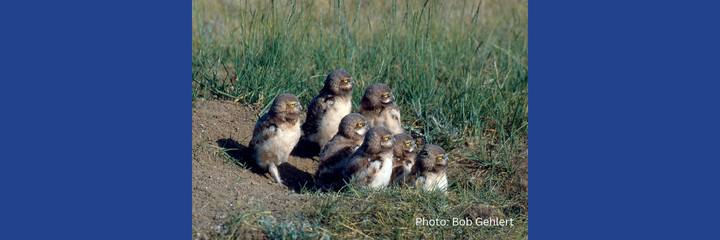
Tiny Talons on the Move-A New Generation of Burrowing Owls Appears
Regina, SK – July 16, 2025 – The middle of July marks the end of an important milestone in the life cycle of a Burrowing Owl and the beginning of another. For the past several weeks, juvenile owls have been tended to and fed by their parents. The young owls are beginning to practice their hunting and flying skills and venturing out on their own to nearby burrows. While this time of year is great for spotting Burrowing Owls, it is a dangerous season for young Burrowing Owls. Owls will often forage in roadside ditches, looking for insects and rodents. “At dusk, the road surface tends to be warmer than the surrounding area, attracting many small insects and rodents”, explains Grace Pidborchynski, Habitat Stewardship Coordinator at Nature Saskatchewan, “as a result, young owls are also attracted to the road and ditch when they begin searching for food”.
Those of us driving in rural Saskatchewan can play our individual parts in conserving the Burrowing Owl species. Pidborchynski suggests that “when driving in rural areas, particularly nearby pasture land, it is important to take a few extra minutes and slow down. This will reduce the risk of owl-vehicle collisions”. Slowing down will also increase your chances of spotting this endangered bird.
To identify a Burrowing Owl, there are some key features to watch for. Look for mottled brown and white feathers, white ‘eyebrows’, and long featherless legs that look like ‘stilts’. They are also small in size – Burrowing Owls are only 9 inches tall (about the size of a Meadowlark). Despite its name, the Burrowing Owl’s burrow is not dug by the owl itself; rather, they use abandoned burrows dug by badgers, ground squirrels (gophers), and other burrowing mammals. If you are lucky enough to spot a Burrowing Owl, you might see it standing at its burrow entrance, on a fence post, or foraging in a ditch.
Since 1987 Nature Saskatchewan’s Operation Burrowing Owl has worked with landholders to conserve Burrowing Owl habitat in Saskatchewan. In addition, the program relies on the participation of landholders to help monitor the Burrowing Owl population. If you spot a Burrowing Owl, please let us know by calling our toll-free Hoot Line at 1-800-667-HOOT (4668) or by EMAIL. Personal and sighting information is never shared without permission.
For further information, please contact Nature Saskatchewan:
Grace Pidborchynski
Habitat Stewardship Coordinator
Phone: (306) 780-9832
Rebecca Magnus
Species at Risk Manager
Phone: (306) 780-9270
